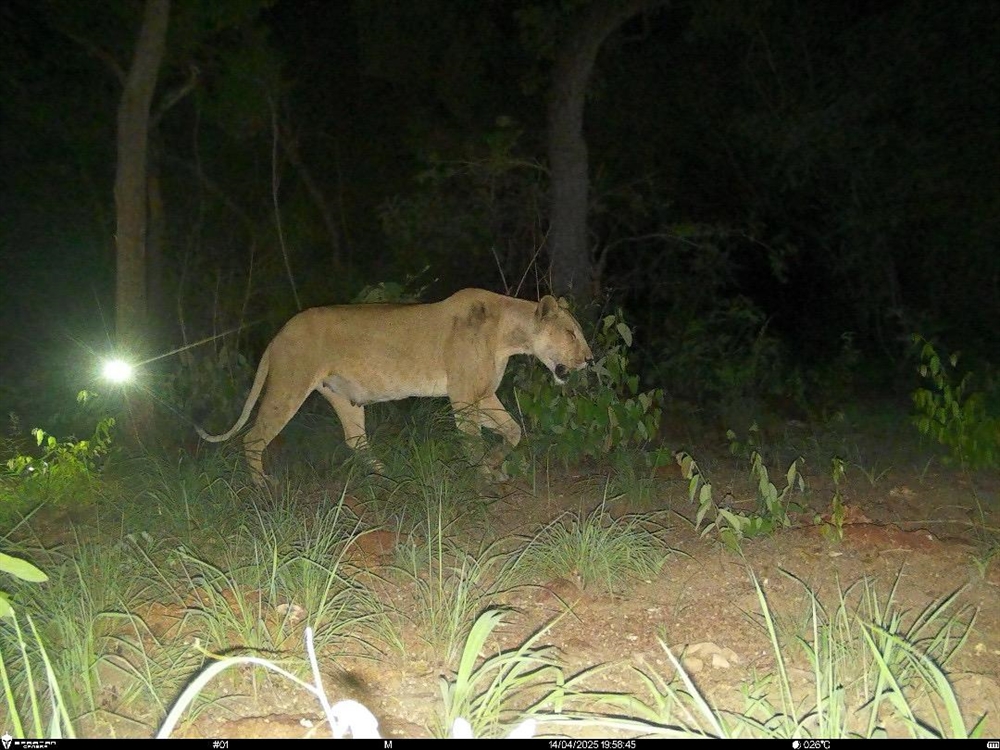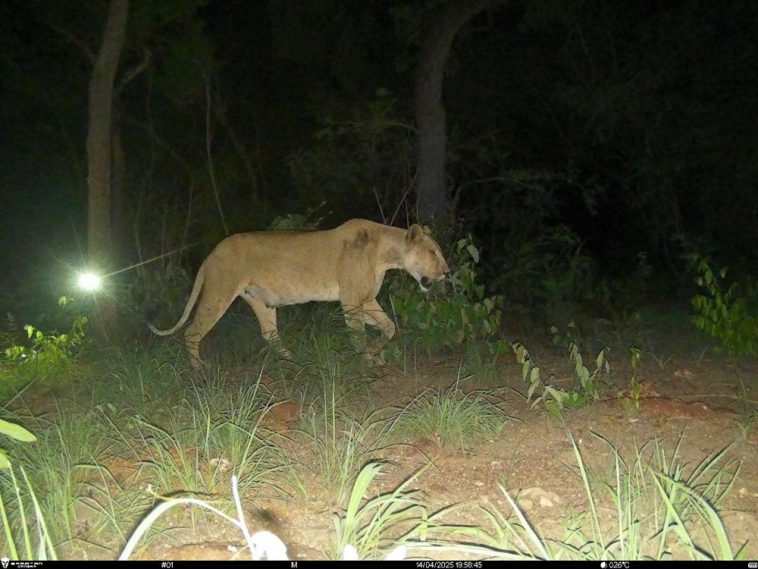
Lion Recovery in Northern Central African Republic: A Beacon of Hope?
The recent camera trap images captured in the Bamingui-Bangoran National Park of the Central African Republic (CAR) have sparked much conversation among wildlife enthusiasts and conservationists alike. After years of only spotting male lions in the region, the discovery of a lactating lioness is a clear signal that the landscape could be witnessing a comeback of its once abundant lion population. For those who follow wildlife conservation closely, this is more than just an isolated incident; it is the beginning of what might be a larger, promising trend in a region loaded with challenges but rich with potential.
The evidence recorded by the Wildlife Conservation Society (WCS) represents a turning point—a moment when conservation efforts, anti-poaching measures, and community engagement seem to be aligning toward a brighter future for lions in the area. This renewed sighting is a standout achievement for the conservation efforts across North-Eastern CAR, a region where lions had been elusive for more than half a decade.
Evidence of Reproduction: The Significance of the First Lioness Sighting
The captured image of the female lion not only marks a milestone in the hunt for a balanced lion population but hints at a more vibrant ecosystem. The lioness appears to be nursing cubs, an indicator of reproduction that has been absent in previous camera trap recordings. This detail is essential because it confirms that the region may be entering a phase where not only survival but the actual growth of the population is possible.
Key indicators from the evidence include:
- The lactating condition of the lioness, suggesting active nurturing.
- The prolonged absence of female sightings in previous monitoring efforts.
- The possibility of previously unrecorded lion cubs, which could signal a rebuilding of the population.
Many conservationists view this as a hopeful sign, a clear marker that the protected landscape still holds promise for driving population recovery. The presence of breeding females can rejuvenate local lion numbers over time, steering the environment toward a healthier and more balanced ecosystem.
The Role of Camera Traps: Technology Meeting Conservation
In today’s world, technology plays an essential role in wildlife conservation. The camera trap method has been especially significant in remote and tricky to reach areas such as Bamingui-Bangoran National Park. By consistently monitoring these regions, conservationists can get a closer look at wildlife behaviors without directly disturbing the animals. These devices, despite their own set of challenging parts such as placement issues and data collection difficulties, have proven handy in capturing even the briefest moments in the lives of elusive creatures like lions.
Camera traps serve several purposes:
- They help document wildlife activity and monitor population dynamics over time.
- They provide data that is invaluable to conservationists trying to figure a path for improvement in wildlife management.
- They give a non-invasive insight into the subtle parts of animal life that might otherwise go unnoticed.
With the delicate balance of ecological factors at play, having such technology is critical to understanding and ultimately ensuring the long-term survival of species that are on the edge.
Anti-Poaching Measures: Tackling the Tangled Issues of Wildlife Trafficking
The recovery signs of the lion population are not accidental. They are the result of deliberate, super important initiatives spearheaded by organizations like WCS in collaboration with local partners. Anti-poaching patrols have been amplified in the region, aiming to counteract poaching—a major threat that has long jeopardized lion and prey populations alike.
The strategy here involves several key components:
- Increased patrolling in crime-prone areas and focused attention on known poaching hotspots.
- Engagement with communities to raise awareness about the benefits of local wildlife and the importance of biodiversity.
- Cooperation with local law enforcement agencies and international bodies to monitor and protect at-risk species.
The initiatives not only work to fend off poachers but also help create safer corridors for the wildlife. With these measures in place, the community is better equipped to get around challenges that previously threatened the survival of these magnificent creatures.
Engaging Transhumance Herders: Community Integration in Conservation Efforts
Developing effective conservation strategies in CAR isn’t only about tracking animals; it’s also about working through the human dimensions of wildlife management. In the region, transhumance herders have long been using routes that cut through critical wildlife habitats, sometimes resulting in conflicts between human activities and wildlife conservation. By working closely with these local communities, conservationists are able to suggest alternative paths, thereby reducing encounters between people and lions.
This program highlights the essential message that wildlife conservation is a team effort. The collaborative initiatives include:
- Dialogues and consultations aimed at understanding the herders’ needs and the local socio-economic conditions.
- Mapping out alternate routes that ease the pressure on national parks while ensuring safe passage for local communities.
- Educational campaigns on the benefits of thriving wildlife populations, which often translate into healthier local ecosystems and opportunities for eco-tourism.
This approach makes headway into some of the tricky parts of balancing human needs with conservation goals, showing that it is possible to figure a path where both wildlife and people can benefit.
Building a Conservation Future: The Larger Picture of NCAR’s Ecosystem
The landscape of North-Eastern Central African Republic, spanning over 113,000 km², includes not only Bamingui-Bangoran National Park but also other critical protected areas like Manovo-Gounda-St Floris National Park and several faunal reserves. This extensive territory still harbors a range of species in addition to lions, such as leopards, caracals, African wildcats, and servals. The discovery of subtle but significant changes in these populations indicates a broader rebound in the ecosystem.
The recovered presence of multiple carnivore species, each with their own subtle details and hidden complexities, accentuates several facts:
- Habitat conditions, even amidst regions loaded with problems like armed conflicts and below-par regulatory enforcement.
- Community-based conservation impacts that are slowly reshaping how wildlife conservation is approached in these areas.
- Technological innovations like camera traps that are allowing us to poke around and capture life in its raw and untampered form.
These aspects combined suggest that if appropriate measures are continuously enforced, the region’s natural wealth could experience an uplifting shift for many species, not just lions.
Improved Population Estimates: Challenges and Promising Signs
For decades, the lion population in NCAR has been on a decline due to persistent threats such as poaching, commercial bushmeat hunting, and illegal resource extraction activities including charcoal, gold, and diamond mining. In spite of these challenges, the largely intact habitat and low human densities present a silver lining for the survival of these magnificent predators.
Experts estimate that while the current lion numbers may be as low as a few dozen individuals, the potential within the national parks remains substantial. Some projections even suggest that just the two major parks could sustain up to 500 lions if protection and community support persist. A more robust lion population has far-reaching implications:
- It could help restore the ecological balance by controlling prey populations.
- It may attract eco-tourism, which in turn can stimulate local economies.
- It underlines how coordinated conservation can steer through the nerve-racking and overwhelming challenges of the modern world.
These improved estimates are based on the quality of the habitat, the resilience of the species, and the effectiveness of safeguarding measures currently in place. Even though the road is filled with twists and turns, the very essence of these numbers is promising—a tangible demonstration that with consistent effort, nature can bounce back.
Big Cats and Biodiversity: The Broader Implications for Wildlife Conservation
Lion recovery in CAR is not the only piece of good news from the conservation front. The resurgence of other wild cats, such as leopards and servals, in the region underscores the interconnectedness of species and the shared benefits of effective conservation policies. When one part of the ecosystem shows signs of thriving, other components can follow suit.
This fact highlights several key points:
- The presence of diverse carnivore species is often a strong indicator of a healthy, balanced ecosystem.
- Recovery efforts focused on one species often have a ripple effect on others, making the overall habitat more resilient.
- Each species, no matter how elusive, plays an essential role in sustaining the natural order and function of its environment.
While the meticulous details regarding each species may seem like a minor part of the overall conservation puzzle, every small victory counts in the larger context of biodiversity preservation.
Community-Led Initiatives: Charting the Course for a Harmonious Future
The conservation story of the Central African Republic is not just about wildlife—it’s also about the people who live within and around these national parks. With local communities and transhumance herders now engaged in conservation efforts, a shared vision is emerging. This vision emphasizes the importance of maintaining healthy ecosystems that provide both environmental benefits and socio-economic opportunities.
Several community-led initiatives have been instrumental in this shift:
- Local educational programs that inform communities about the benefits of ecological preservation.
- Workshops that help herders find alternative pathways, thus minimizing the chances of human-lion conflict.
- Collaborative projects between conservation organizations and local governments that aim to preserve and protect wildlife habitats.
These programs demonstrate that by working together, it is possible to get into the finer details of longstanding issues and propose realistic, implementable solutions. A harmonious balance between human development and conservation is not only desirable but becomes achievable when every stakeholder is involved.
Working Through the Tricky Parts: The Challenges of a Tense Conservation Landscape
Despite the promising signs, the road ahead remains daunting for the region’s wildlife. The landscape is riddled with problems ranging from commercial bushmeat hunting to illegal resource extraction activities. Political instability and regional insecurity further complicate efforts to provide a safe haven for wildlife. In such an environment, progress can seem nerve-racking and overwhelming.
Some of the most complicated pieces include:
- Continued conflict and illegal activities that directly threaten conservation efforts.
- The challenge of ensuring that local communities receive the benefits of successful conservation.
- The volatile balance between wildlife protection and economic pressures in resource-rich areas.
Conservationists are therefore tasked with the dual challenge of responding to immediate threats while also investing in long-term solutions that address underlying local and political factors. Only through persistent, multi-level strategies can these tangled issues hope to be resolved over time.
Global Collaboration: The Power of International Support in Conservation
The ongoing commitment from international partners has been a cornerstone of progress in the Central African Republic. Organizations such as the European Union, Fondation Segré, The Rob Walton Foundation, and specialized funds like the Wildlife Conservation Network’s Lion Recovery Fund have played important roles in making these conservation successes possible.
International support shows up in several ways:
- Funding for anti-poaching patrols and advanced technology like camera traps.
- Expertise shared from across the globe to tailor solutions specific to the needs of the region.
- Strengthening local authorities and conservation bodies to build a more sustainable framework for wildlife protection.
This collaborative approach is essential because wildlife conservation, particularly of apex predators like lions, benefits greatly from a multi-faceted support system. While local measures remain critical, the addition of global resources and knowledge helps steer through the mixed set of challenges that continue to face these fragile landscapes.
Assessing the Broader Impact on Biodiversity and Future Implications
The recent sighting of a lioness, possibly caring for her cubs, offers more than just a glimmer of hope for a single species—it provides us with a pathway to re-assess the broader implications for biodiversity in the region. The ripple effect of such a recovery may lead to enhanced ecosystem resilience and improved environmental health across North-Eastern CAR.
Some of the broader impacts might include:
- A resurgence in predator populations, which help maintain the balance of prey species and overall ecosystem function.
- An increased likelihood of attracting eco-tourism that drives local reinvestment in wildlife preservation and community development.
- The opportunity for ongoing, uninterrupted research that could shed light on fine shades of ecosystems that are under threat from multiple angles.
These insights have generated many discussions among conservation experts who believe that a thriving lion population can act as a flagship indicator for the overall success of conservation efforts in the region. The return of an apex predator like the lion also hints at the possible revitalization of other aspects of the ecosystem that are essential for the survival of multiple species.
Finding Your Path Through Conservation Efforts: Lessons Learned and Future Outlook
Every conservation journey is loaded with challenges and delicate balances to maintain. From technology-based monitoring to community outreach, the recovery of lions in the Central African Republic is a textbook example of how multiple approaches can work together for a common goal. The success of these efforts rests on the ability to work with local communities, manage wildlife threats, and harness international support to build a resilient conservation framework.
Reflecting on these achievements provides several key lessons:
- Effective conservation is not a one-off achievement but an ongoing commitment that requires persistent effort and flexible strategies.
- The importance of combining technological innovations with grassroots community involvement cannot be overstated.
- Every small victory, like the sighting of a lactating lioness, acts as a stepping stone towards larger environmental success.
Looking ahead, it is clear that these coordinated efforts must persist if the full recovery of the lion population—and indeed the entire ecosystem—is to be realized. There will always be tricky parts in this journey, such as occasional security issues, challenges with new conservation policies, or even the simple fact of weathering the natural fluctuations of wildlife populations. However, the progress made in North-Eastern CAR shows that even the most tangled issues can be managed with coordinated international, local, and technological support.
Bridging the Gap Between Conservation Theory and Real-World Results
One of the most encouraging aspects of this recovery is that it bridges the gap between conservation theory and something tangible in the field. While extensive planning, combined effort with governments, and the use of advanced monitoring technologies have been cited in countless reports as the secret ingredients to conservation success, the reappearance of a breeding lioness is the concrete evidence that these measures work.
Several factors contribute to this success:
- Rigorous monitoring and data collection that have helped figure a path through the overwhelming problems.
- Effective management agreements, such as the 25-year delegated management agreement that WCS holds with the government of CAR.
- The ability to adapt strategies based on new evidence and field data, ensuring that conservation efforts remain responsive to the real-world environment.
This real-world success is a hopeful reminder that, with perseverance and a thorough understanding of both the subtle parts of wildlife behavior and the surrounding social dynamics, even regions marked by intense challenges can witness significant recovery. The lion’s return isn’t just a win for the species—it is a win for nature, for local communities, and for conservationists around the world who continue to work through numerous nerve-racking issues.
Looking Ahead: The Future of Big Cat Conservation in Central Africa
While the recovery of the lion population in North-Eastern CAR is undoubtedly inspiring, the journey is far from complete. Future conservation efforts will have to address not only the immediate challenges of poaching and illegal resource extraction but also the shifting context of a changing global landscape. The recovery witnessed in this region could serve as a blueprint for other areas that may be struggling with similar intricate problems.
The outlook for big cat conservation in Central Africa includes several promising strategies:
- Expanding the scope of technological monitoring across a broader area to capture more fine points of wildlife activity.
- Enhancing collaborations between local communities, governments, and international partners for sustained support.
- Leveraging success stories such as the return of a breeding lioness to galvanize further protection measures and community-driven conservation projects.
With these strategies in mind, conservationists are optimistic about overcoming the nerve-racking twists and turns that have long characterized wildlife protection efforts in this region. The survival of apex predators is not just a matter of pride for the conservation community—it is the foundation upon which entire ecosystems depend.
The Ripple Effect: How Lion Recovery Impacts Local Ecosystems and Economies
The reemergence of a breeding lioness has profound implications that extend far beyond the animal kingdom. When an apex predator recovers, its effect is felt throughout the ecosystem; this can lead to improved management of prey populations, healthier vegetation, and, ultimately, a more balanced natural environment. A thriving lion population can also boost local economies by attracting eco-tourists, thereby injecting much-needed revenue into communities that have historically struggled with economic instability due to conservation conflicts.
The ripple effects can be summarized as follows:
| Impact Area | Potential Benefits |
|---|---|
| Ecological Balance | Regulated prey populations; healthier vegetation and overall ecosystem resilience. |
| Local Communities | Enhanced opportunities for eco-tourism, education, and sustainable development. |
| Conservation Funding | Increased global attention resulting in more financial and technical support for local projects. |
This table makes it clear that the conservation of a single species, such as lions, can have a profound, far-reaching impact on the broader local and even global environment.
Taking the Wheel: Community Empowerment and Local Leadership
An integral part of conservation success lies in the empowerment of local communities. When transhumance herders and other local stakeholders are given a seat at the table, conservation measures tend to be more effective and sustainable. In the Central African Republic, empowering locals to get into decision-making processes and spearhead initiatives ensures that protection measures are not seen as imposed from outside but are homegrown solutions aimed at benefiting everyone.
Key strategies for community empowerment include:
- Capacity Building: Training and vocational programs aimed at equipping community members with skills needed to monitor and protect their wildlife resources.
- Incentive Programs: Initiatives designed to offer tangible benefits—such as access to eco-tourism revenues—in exchange for proactive conservation involvement.
- Local Leadership: Engaging local leaders and influencers to spread awareness and help figure a path through cultural and practical obstacles in conservation work.
The local leadership model not only builds morale but also ensures that conservation policies are refined with an understanding of the cultural and economic realities on the ground. It is a powerful reminder that wildlife conservation is as much about people as it is about animals.
Reflecting on the Journey: Balancing Hope with Real-World Challenges
Every conservation narrative is replete with both celebration and caution. The sighting of a nurturing lioness gives us a moment to celebrate promising signs, yet it also reminds us of the full spectrum of challenges that still lie ahead. The region’s conservation landscape is, indeed, full of tricky parts, tangled issues, and nerve-racking dilemmas that require constant attention and adaptability.
Reflecting on these realities, it is worth considering the following takeaways:
- Innovations like camera traps, when combined with robust anti-poaching measures, yield results that are both inspiring and quantifiable.
- Even in regions that are on edge from political and economic instability, concerted efforts can pave the way for meaningful recovery.
- The integration of multiple approaches—from community engagement to international collaboration—is the only viable path to balance hope with the many twists and turns of conservation work.
While the road to full recovery remains long and occasionally fraught with complicated pieces, the progress made so far is an indication that sustained effort and smart strategies can truly make a difference.
Concluding Thoughts: A Call for Continued Support and Informed Action
The story unfolding in North-Eastern Central African Republic illustrates that neither nature nor human endeavours work in isolation. The reappearance of a breeding lioness is a testament not only to the resilience of wildlife but also to the power of comprehensive, community-based conservation. It reminds us that every strategic step—be it the use of state-of-the-art technology, rigorous anti-poaching patrols, or the empowerment of local communities—plays a critical role in steering through the nerve-racking challenges of preserving our planet’s natural heritage.
This moment, captured by a camera trap in the dense stretches of Bamingui-Bangoran National Park, is a symbol of hope and an invitation for all of us—policy makers, conservationists, local stakeholders, and international partners—to commit to a future where wildlife and human progress grow hand in hand. We must continue to work diligently through the confusing bits and overlapping challenges, learning from both our successes and setbacks.
As we move forward, it is essential to remember that every small victory—such as the re-emergence of a lioness with her cubs—contains the seed of much larger triumphs. The path may be filled with intimidating twists and turns, and the journey might often feel overwhelming, but each determined step paves the way for a transformed future where both nature and communities can thrive together.
Now, more than ever, it is super important to stand together for wildlife, to support conservation measures that protect these majestic creatures, and to ensure that future generations inherit a world where the roar of the lion echoes through thriving, balanced ecosystems. Let the return of a breeding lioness in CAR serve as a rallying cry—for further research, sustained funding, informed actions, and stronger cross-border collaborations.
In Summary: Key Insights and Takeaways
Let’s recapitulate the main points discussed in this opinion editorial:
- A newly captured image from Bamingui-Bangoran National Park reveals what appears to be a breeding lioness, suggesting active reproduction after years of only male sightings.
- Technology, especially camera traps, is proving to be an invaluable asset for monitoring wildlife in remote, challenging areas.
- Robust anti-poaching patrols, bolstered by international and local support, are helping curb illegal activities that pose major threats to wildlife.
- Engaging community stakeholders, particularly transhumance herders, has been a game-changer in finding alternative routes to reduce human-animal conflicts.
- A healthy apex predator population not only benefits the ecosystem but can also significantly boost local economies through eco-tourism and sustainable development.
- Despite a landscape that is full of problems and intimidating challenges, coordinated conservation efforts show that even long-standing issues can be managed successfully.
These insights serve as a comprehensive reminder that while the road ahead is dotted with complicated pieces and nerve-racking obstacles, the progress already witnessed in North-Eastern CAR is an undeniable achievement that must be nurtured and expanded upon.
A Final Word: Our Shared Responsibility for the Future
In closing, the reappearance of a nurturing lioness in one of Africa’s most challenging landscapes exemplifies the extraordinary resilience of nature when given the appropriate support. It is a powerful message to everyone invested in the preservation of our natural world: no matter how tangled the issues or overwhelming the path may seem, each well-planned action contributes to a larger movement toward a sustainable, balanced future.
As readers, conservation enthusiasts, and global citizens alike, we are urged to maintain our focus on these promising developments. Our continued support, advocacy, and informed action are indispensable in ensuring that daunting challenges do not stifle the potential for recovery but instead become opportunities for groundbreaking triumphs.
The journey is long and occasionally winding, but with clear strategies, community involvement, and persistent international efforts, the revival of lion populations in the Central African Republic can serve as a model for wildlife conservation across the globe. Let us all commit to taking a closer look at the fine details, managing our way through the challenges, and working hand in hand to protect our planet’s irreplaceable natural treasures.
Originally Post From https://newsroom.wcs.org/News-Releases/articleType/ArticleView/articleId/24893/Signs-of-Lion-Recovery-WCS-Camera-Trap-Captures-First-Lioness-in-Northern-CAR-since-2019.aspx
Read more about this topic at
Lions for Hope Sports Complex – Chicago Sports Complex
Our Facilities – Lions for Hope


